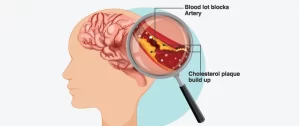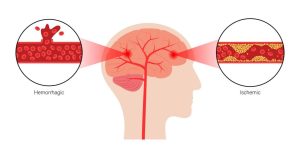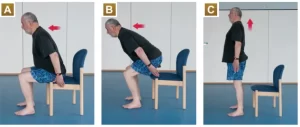What is a stroke and how exercise can help stroke patients
Stroke and exercise
Exercise plays a significant role in the prevention of a stroke and in reducing the chances of it occurring.
Incidence of stroke
Around the world, there are 12.2 million new strokes per year and one every 3 seconds.
1 in 4 people will have a stroke in their lifetime.
Two types of strokes
Ischaemic stroke
A stroke can be caused by the blood supply to the brain being blocked. It usually is a blood clot that blocks the blood supply. If blood cannot get through to the brain, then it will be deprived of oxygen and nutrients which can result in long-term damage.

Ischaemic stroke
Haemorrhagic stroke
A stroke can be caused by bleeding in the brain. Blood can leak from a ruptured blood vessel. The leaking blood is like a bruise that injures part of the brain.

Haemorrhagic and ischaemic stroke
What are the causes of strokes?
A common cause of Ischaemic stroke is atherosclerosis. This is when cholesterol builds up as plaques on the inner walls of arteries. These clots often form in the carotid arteries in the neck, which are the brain’s main blood supply.
The main cause of haemorrhagic stroke is high blood pressure. The pressure can break major arteries deep within the brain, which can cause a haemorrhage. Other potential causes can include blood-thinning medications and illegal drugs such as cocaine.
What are the risk factors for a stroke?
Metabolic risks
High systolic blood pressure, high BMI, high fasting blood glucose and high total cholesterol.
Behavioural factors
Smoking, unbalanced diet, and low physical activity.

Smoking is a risk factor
What are some management strategies in reducing the risk of a stroke?
- Improving socio-economic conditions
- Encouraging healthy lifestyles
- Reducing tobacco use and alcohol consumption
- Affordable healthy foods
- Increasing public physical activity facilities
How can exercise play a role in stroke management?
Regular exercise can help prevent a stroke from occurring. Exercise helps reduce total cholesterol, maintain healthy blood pressure and improve body weight which all play a role in the prevention of a stroke.
If you have experienced a stroke, it is encouraged that you engage in exercise to help with your recovery and to reduce the re-occurrence of a stroke. Exercise can help increase mobility and physical strength in body parts that are affected by the stroke. For example, if an individual has a weakened left arm due to a stroke, they are encouraged to do strength exercises involving that left arm to aid in their recovery. It is also important to avoid prolonged sedentary behaviour to reduce the risk of further complications from occurring.
What type of exercise?
Exercises can involve strength exercises, balance training, walking re-training and cardio. These exercises can restore the body’s physical function and assist in cognitive functions such as memory retention and learning. It can also improve mood and emotional regulation which is important when recovering from a stroke.

Sit to stands are an effective leg exercise after a stroke
If fatigue is a barrier to committing to an exercise program post-stroke, then some ways to make exercise more achievable include:
- Breaking it up into small bouts throughout the day (I.e. instead of doing 30 minutes at one time, try and do 5-10 minutes)
- Doing the program when you have the highest energy in your day
- Doing it with a partner or a friend to help increase your accountability
- Group exercise can help reduce the perception of fatigue
- Starting with lower intensity exercises and building up gradually.
- If your fatigue is persistent and concerning you, a visit to the GP might be useful.
The information provided in this article is considered general advice. For specific advice related to your individual circumstances, speak to your healthcare provider.
If you like what you’re hearing from us Fit Clinic, subscribe to our social media channels, YouTube, Facebook, and Instagram. You can find us at Fit Clinic AU.
Otherwise, pop over to our website and subscribe there fitclinic.com.au and hear more from us.
